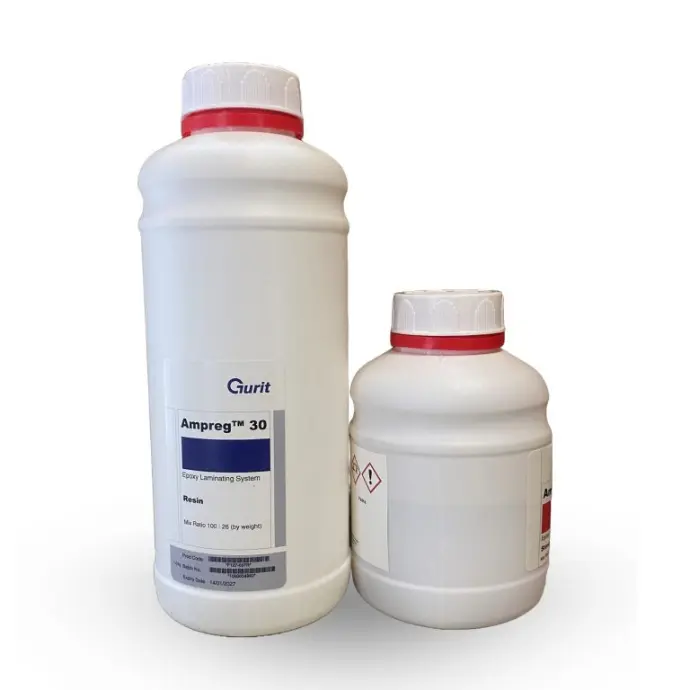Product Description
EPOXY AMPREG 30 H+K STD 1,26 KG
Ampreg 30 laminating epoxy is designed for the production of large composite parts. It is suitable for hand lay-up and vacuum-assisted processes. Ampreg 30 contains fewer hazardous substances, making it more user- and environmentally friendly.
Benefits
- Low viscosity and good curing behavior.
- Good mechanical properties for the laminate.
- DNV-GL approved, Lloyd’s approval in progress.
Hardeners:
- No long-term health effects
- Free of CMR (carcinogenic, mutagenic, or toxic to reproduction substances), SVHC (Substances of Very High Concern), and AEP (Alkylphenol Ethoxylates)
- Harmless to the environment
Viscosity (resin + hardener) | Gel time at 25 °C | |
Fast hardener | 900 cP | 0,5 h |
Standard hardener | 750 cP | 1,25 h |
Slow hardener | 350 cP | 4 h |
Working Instructions
Before working with epoxy, ALWAYS ensure good ventilation and skin protection.
The optimal working temperature for Ampreg 30 is 18 °C to 25 °C. At lower temperatures, the epoxy thickens and becomes unusable. At higher temperatures, the working time is significantly shorter. Maximum relative humidity is 70%.
Mixing
Resin: Fast hardener | Resin: std hardener | Resin: slow hardener | |
Mixing ratio by weight | 100 : 26 | 100 : 26 | 100 : 26 |
Mixing ratio by volume | 100 : 31 | 100 : 31 | 100 : 32 |
Always follow the specified epoxy mixing ratio—do not add too much or too little hardener. The best tool for measuring is an accurate scale wrapped in a clear plastic bag. Medical syringes are excellent for measuring small amounts of resin and hardener (use separate syringes for each). After measuring the correct amounts into a container, mix thoroughly—scraping the bottom and sides of the container with a mixing stick. Epoxy will not cure properly if the mixing ratio is incorrect, the mixing is inadequate, or the temperature is too low.
Hand Laminating
Always start by applying resin first, then place the fabric on top. Make sure no air is trapped under the fabric. Air can be removed by rolling with an aluminum roller, dabbing with a brush, or pulling it out with a rubber squeegee. For small areas, a brush is sufficient. For larger jobs where more than 1 m² of fabric is used, it’s better to use both a wet-out roller and a brush (and finish with a bubble roller). Additional fabric layers can be laminated immediately, working from largest to smallest.
Vacuum Bagging
See detailed instructions here. >>>
Curing
The minimum curing temperature is 18 °C. The curing time before demolding is 48 hours with the slow hardener and 16 hours with the fast hardener. Excellent mechanical properties are achieved if the part is post-cured for 5 hours at 70–80 °C or 16 hours at 50 °C. Post-curing should be done immediately after laminating, gradually increasing the temperature at a rate of 10 °C per hour.
Safety
Before handling epoxy, ALWAYS ensure good ventilation and skin protection. Wear a long-sleeved shirt and disposable gloves resistant to epoxy (e.g., nitrile), and don’t forget eye protection. Uncured epoxy resin is a strong skin sensitizer. Fully cured epoxy is not hazardous to health.
Hazard Statements
Resin:
H315 – Causes skin irritation. H317 – May cause an allergic skin reaction. H319 – Causes serious eye irritation. H411 – Toxic to aquatic life with long-lasting effects. P261 – Avoid breathing vapour. P264 – Wash hands thoroughly after handling. P272 – Contaminated work clothing should not be taken off-site. P273 – Avoid release to the environment. P280 – Wear protective gloves, protective clothing, and eye protection. P302+P352 – IF ON SKIN: Wash with plenty of water.
Hardener:
H314 – Causes severe skin burns and eye damage. H317 – May cause an allergic skin reaction. H412 – Harmful to aquatic life with long-lasting effects. P260 – Do not breathe vapour. P264 – Wash hands thoroughly after handling. P272 – Contaminated work clothing should not be taken off-site. P273 – Avoid release to the environment. P280 – Wear protective gloves, protective clothing, and eye protection.
P301+P330+P331 – IF SWALLOWED: Rinse mouth. DO NOT induce vomiting.
Storage
Resin and hardener should be stored in their original containers, tightly sealed, in a warm and dry place. The hardener, in particular, reacts easily with air. Storage temperature should be between 10–25 °C. Large temperature fluctuations may cause crystallization. The shelf life for both resin and hardener is 24 months.
